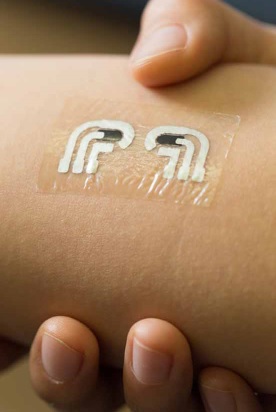
Researchers at the University of California, San Diego have recently published a report stating that they have invented a flexible ‘temporary tattoo’ sensor that can be worn on a patient’s arm to accurately measure glucose levels. These UCSD nanoengineers tout that the device is not only reliable, but painless as well, for diabetes patients who may find the constant finger prick to draw blood annoying and uncomfortable.
Amay Bandodkar served as the lead researcher for the project. He was joined in the study by additional UCSD nanoengineers Wenzhao Jia, Ceren Yardımcı, Xuan Wang, and Julian Ramirez, as well as Professor Joseph Wang, Director of the Center for Wearable Sensors and Distinguished Professor in the NanoEngineering Department.
Bandodkar’s glucose-testing temporary tattoo uses a mild electrical current to extract and measure blood sugar levels in the fluid between the skin cells of a patient. The flexible device is comprised of electrodes that are printed on a thin adhesive paper that can be thrown away after it is used. In fact, the sensors are only designed to be worn by patients for one day before being discarded.
As the UCSD report states, “a very mild electrical current applied to the skin for 10 minutes forces sodium ions in the fluid between skin cells to migrate toward the tattoo’s electrodes. These ions carry glucose molecules that are also found in the fluid. A sensor built into the tattoo then measures the strength of the electrical charge produced by the glucose to determine a person’s overall glucose levels.”
As for the costs associated with the technology, Bandodkar said in a statement, “These are extremely inexpensive — a few cents — and hence can be replaced without much financial burden on the patient.”
At this time, the device cannot provide a numeric value for blood sugar levels, but the UCSD researchers have indicated that advancements are already underway that will give the sensor “Bluetooth capabilities to send this information directly to the patient's doctor in real-time or store data in the cloud.”
Bandodkar said this device could also open the door to exploring other uses for the technology, such as delivering medicines through the skin or discovering other important metabolites in the body. He went on to state that the Center for Wearable Sensors “envisions using these glucose tattoo sensors to continuously monitor glucose levels of large populations as a function of their dietary habits.”
Over time, data collected from this research could give more insight into the causes and prevention of diabetes.
Interestingly, this is not the first time an organization has attempted to release such a device. In 2002, the GlucoWatch was marketed as a similar technology, but its use was eventually suspended because patients said it irritated their skin. Bandodkar says their new temporary tattoo sensor avoids such irritation through the use of a lower electrical current.
Only time will tell whether this noninvasive and pain-free technology will catch on among medical professionals and patients. But the fact remains that diabetes impacts millions of people worldwide, so advances in research to determine causes and methods of prevention will remain a medical industry focus for many years to come.
Via Mashable and the University of California, San Diego
Advertisement
Learn more about Electronic Products Magazine





